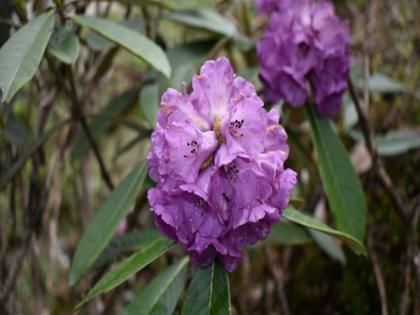Of Rituals and Rhododendrons: Exploring sacred landscapes of Buddhism in Sikkim
By ANI | Published: June 28, 2023 12:14 PM2023-06-28T12:14:22+5:302023-06-28T12:15:04+5:30
Sikkim [India], June 28 : Nestled in the bosom of the Eastern Himalayas, the Indian state of Sikkim blooms ...

Of Rituals and Rhododendrons: Exploring sacred landscapes of Buddhism in Sikkim
Sikkim [India], June 28 : Nestled in the bosom of the Eastern Himalayas, the Indian state of Sikkim blooms with the radiance of rhododendrons. This enchanting landscape is not only the natural habitat of these vibrant flowers but also the spiritual home of the region's Buddhist population. Each year, they participate in ritualistic practices among the rhododendrons, creating a sacred bond with nature that resonates with the essence of Buddhism.
Sikkim, often referred to as 'The Land of Mystic Splendor', is an oasis of tranquillity where tradition and nature come together in a profound and symbiotic relationship. The vibrant rhododendrons that blanket the hills in a riot of colour are intrinsic to the culture and spirituality of the Sikkimese people. These flowers, besides their aesthetic appeal, have come to symbolize the interdependence of life, a core Buddhist concept, and thus hold a special place in the hearts of the locals.
Buddhism, a religion that advocates peace, compassion, and coexistence, finds its expression in Sikkim's landscape. The region's monasteries, often perched atop hills overlooking valleys of rhododendrons, are testaments to the seamless integration of nature and spirituality. They are more than just places of worship; they are spiritual sanctuaries that invite devotees and travellers alike to immerse themselves in a spiritual journey amidst nature.
The Buddhist rituals in Sikkim are deeply rooted in nature. The yearly 'Saga Dawa' festival on Buddha Purnima, commemorating the enlightenment of Gautama Buddha, sees the monastic community and locals engaging in processions through rhododendron forests. As monks chant mantras and locals offer prayers, the ritual becomes a shared celebration of life and interconnectedness. The rhododendrons, in full bloom, seem to echo the sentiment with their vibrant presence.
Buddhists believe that every living being has a Buddha nature, a seed of enlightenment, which can be nurtured through mindfulness and compassion. In Sikkim, this philosophy extends to the rhododendrons, revered not just as flora but as sentient beings. Their existence is intertwined with the spiritual practices of the people, creating a sacred landscape that transcends the physical realm.
The rhododendrons of Sikkim are not just flowers; they are symbols of resilience, blooming year after year in the harsh Himalayan weather, and they are metaphors for the Buddhist teachings of persistence in the face of adversity. Their vivid hues against the backdrop of the stark mountains mirror the Buddhist belief in the potential for enlightenment amidst the trials of life.
In a world increasingly disconnected from nature, Sikkim stands as a beacon of hope. Here, spirituality and nature are not opposing forces but partners in the dance of existence. Through their rituals among the rhododendrons, the Sikkimese people demonstrate a way of living that respects and celebrates the sacredness of all life forms.
The story of Buddhism in Sikkim is a unique testament to the power of nature in shaping spiritual practices. It is a narrative of faith and flora, of rituals and rhododendrons, and of a community living in harmony with nature. As we delve into this sacred landscape, we are reminded of our shared responsibility to preserve and respect the natural world, just as the Buddhists of Sikkim have done for centuries.
Through the interplay of rituals and rhododendrons, the people of Sikkim have cultivated a sacred landscape that transcends the physical and reaches into the spiritual. The rhododendrons, resplendent in their seasonal bloom, serve as a reminder of the cyclic nature of lifea theme central to Buddhist philosophy.
In their silent resilience, these flowers bear witness to the passage of time and the changing seasons, standing as a living testament to the teachings of Buddhism. They remind us of the transient nature of life and the importance of finding peace within this transience, a key tenet of Buddhist thought.
The Buddhist community of Sikkim, through their deep respect for nature and their mindful living, offer an insight into a form of spirituality that is deeply entwined with the environment. Their sacred landscapeswhere nature and faith are intermingledserve as a reminder of our intrinsic connection with the natural world, a bond that is often forgotten in the hustle and bustle of modern life.
In conclusion, the story of Sikkim's sacred landscapes is not just a tale of unique cultural practice. It is a narrative that prompts us to reflect on our relationship with nature, urging us to foster a deeper appreciation for the natural world and its profound influence on our spiritual journeys. Whether it's through the vibrant colours of the rhododendrons or the resonant chants from the monasteries, the sacred landscapes of Sikkim serve as a beautiful reminder of the symbiotic relationship between nature and spirituality.
As we navigate through the chaos of the 21st century, may we find inspiration in the rituals and rhododendrons of Sikkim, adopting a more mindful approach towards nature, and recognizing its undeniable role in shaping our spiritual perspectives. After all, in the grand tapestry of life, we are but a single thread intertwined with numerous others, each one equally crucial in maintaining the delicate balance of our shared existence.
So, let us celebrate the sacred landscapes of Sikkim, where nature and spirituality come together in a beautiful symphony of coexistence. Let us learn from the Buddhists of Sikkim, who show us how to live in harmony with nature, respecting and cherishing it, not just for its resources, but for its spiritual significance. Let us remember that every rhododendron, in its radiant bloom, is a call to mindfulness, a beckon towards a path of compassionate living and spiritual enlightenment.
Disclaimer: This post has been auto-published from an agency feed without any modifications to the text and has not been reviewed by an editor
Open in app